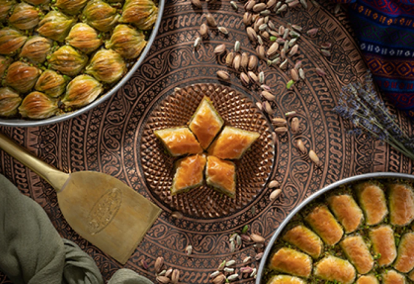10 August 2021

Baklava, with its rich history and intercultural past, is a dessert that sweetens not only the palate but also the stories. In this article, we will take an in-depth look at the origins of baklava, its journey from Mesopotamia to the present day, and how it found a unique place in different cultures. This delicious journey, spanning from ancient times to Ottoman cuisine, and from the Middle East to the Balkans, reveals that baklava is not just a dessert, but also a cultural and historical heritage. Shaped over centuries, this dessert has become a meeting point for different societies and has left a distinct mark in every culture.
The history of baklava dates back to the early days of the Persian Empire. Back then, it was a dessert made only in royal kitchens and symbolized wealth and grandeur. Over time, baklava spread to the Ottoman Empire, where it became one of the most beloved desserts in the royal kitchens. Ottoman chefs developed baklava by using different ingredients and cooking techniques, bringing it closer to its modern form.
As baklava spread across the diverse ethnic and cultural groups within the vast borders of the Ottoman Empire, each region created its own version of baklava. This diversity is proof of baklava's intercultural journey. For instance, in Greece, baklava is typically made with honey and walnuts, while in Arab countries, more spices and different syrups are used.
Throughout history, baklava has gained importance not only for its taste but also as a product of intercultural interaction. This dessert is a delicious representation of the influence and unity of different peoples and civilizations in the culinary arts. Today, baklava remains a beloved dessert worldwide and is an essential part of celebrations and special occasions. This delectable treat carries with it a rich cultural and historical heritage, representing much more than just a dessert from the past to the present.

 Baklava
Baklava Purple Mussel Baklava
Purple Mussel Baklava Carrot Slices
Carrot Slices Şöbiyet
Şöbiyet Winding
Winding Square Baklava
Square Baklava Mussel Baklava
Mussel Baklava Nightingale's Nest
Nightingale's Nest Bohca
Bohca Walnut Baklava
Walnut Baklava
 Baklava
Baklava Carrot Slices
Carrot Slices Nightingale's Nest
Nightingale's Nest Purple Baklava
Purple Baklava Mussel Baklava
Mussel Baklava Walnut Baklava
Walnut Baklava Leaf Shabiyet
Leaf Shabiyet Winding
Winding Şöbiyet
Şöbiyet Pack
Pack
 Kadayif
Kadayif Peanut Butter
Peanut Butter Plain Cookies
Plain Cookies Peanut Cookies
Peanut Cookies Packaged Peanut Butter
Packaged Peanut Butter Pistachio
Pistachio Water Pastry
Water Pastry